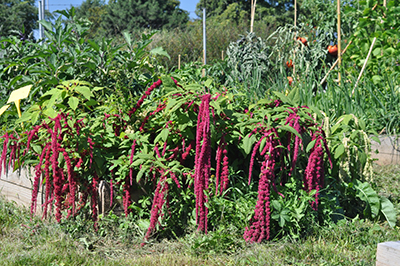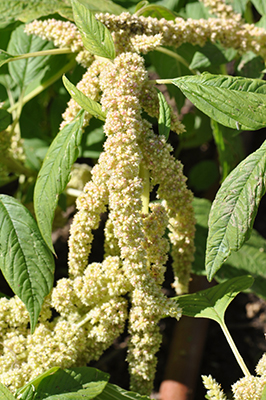Amaranthus caudatus




| ENG | love-lies-bleeding, pendant amaranth, foxtail amaranth |
| SK | Láskavec chvostnatý |
| CZ | Laskavec ocasatý |
| PL | Szarłat zwisły |
| HU |
Taxonomic characteristic:
Order: Caryophyalles, Family: Amaranthacae, Genus: Amaranthus
Using
Amaranthus leaves may be eaten as a salad vegetable. The seed can be popped (the same way as popcorn), or cooked. The mild flavored leaves and seeds are very nutritious (rich in vitamins and minerals).
Medically uses: the plant is an astringent, anthelmintic and diuretic. It is used in the treatment of stranguary and is applied externally to scrofulous sores.
Botanical description and occurrence:
Amaranth is an annual herbaceous plant or shrub that at maturity can reach 3 meters (or more). At the base of the stem or at mid-height of the plant, some ramifications arise from the axils of the leaves. The number of branches of the plant depends directly on the density of crop plants. Leaves are stalked and compound, alternate, rhomboid-shaped, elliptical or oval. Glabrous on both surfaces with pronounced veins. Leaves may be from green-yellow to deep red. Its size ranges between 6.5 and 15 centimeters. The inflorescence can be terminal or axillary. They also vary from being erect or decumbent, and they can offer different colors depending on the variety: yellow, orange, brown, red, and pink to purple. The panicle is between 50 centimeters and 1 meter. Its flowers are unisexual, small, with stamens at the apex of the glomerulus and pistils. The seeds are small, spherical, lenticular, shiny, white, yellow, gold, red, pink or black, depending on the variety of plant. Their size is very small, between 1 and 1.5 millimeters in diameter.
Amaranth is native to the Andean valleys of South America and its geographical area extends from southern Ecuador to northern Argentina.
Reproduction:
Generative: Indoors sow start 6-8 weeks before last frost. Set out plants after last frost date (seedlings transplant outdoors in late May or early June), or make outdoor sow in late spring or early summer (when soil temperatures are above 21°C).
Vegetative: Cuttings of growing plants root easily
Harvesting: The amaranth seeds should be harvested when they fall easily from the dried flower heads (in the end of summer).
Why to have the plant in your garden:
It is interesting from edible and medicinal uses. It may be used in beds or borders, or for interesting edging along walks and paths. Flowers can be used for fresh or dried arrangements, and birds love the seedheads. Mature plants are additionally drought tolerant.
Text:
Ing. Ján Farkaš, SUA, Nitra, Slovak Republic
Photo:
Dr. Ján Mezey, Dr. Ivana Mezeyová, SUA, Nitra, Slovak Republic
Links to scientific articles (if it is possible):
http://www.missouribotanicalgarden.org/PlantFinder/PlantFinderDetails.aspx?kempercode=a558
http://www.learn2grow.com/plants/amaranthus-caudatus/
https://www.rhs.org.uk/plants/details?plantid=113
http://www.seedaholic.com/amaranthus-caudatus-drooping-love-lies-bleeding.html
http://www.pfaf.org/USER/Plant.aspx?LatinName=Amaranthus+caudatus

